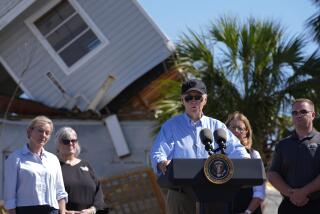Rescuing the living, recovering the dead: Storm Harvey moves on, but ravaging floods left behind
- Share via
Reporting from Houston — With the weakened remnants of former Hurricane Harvey delivering drenching inland rainfall and yet more flooding Thursday, Houston and the vast area already hammered by the massive storm grappled with fresh perils as the waters began to recede, leaving behind a stew of toxic muck.
Texas Gov. Greg Abbott called for a day of prayer across his stricken state, and rescuers continued to pluck victims from floods inundating small towns. A major hospital in Beaumont, east of Houston, was forced to evacuate after the municipal water supply failed.
The death toll from the storm — which roared ashore last Friday as a hurricane and was downgraded first to a tropical storm, then overnight to a tropical depression — reached 31, but was expected to rise, perhaps sharply. The grim work of recovering the bodies of those who were trapped in homes or vehicles gathered speed in Houston, the nation’s fourth-largest city.
Methodical block-by-block searches were underway in some of the hardest-hit areas, said Houston’s assistant fire chief, Richard Mann.
The disaster’s full scope and scale was still emerging, with new reports of damage pouring in hourly. White House homeland security advisor Tom Bossert told reporters in Washington that 100,000 homes had been either damaged or destroyed.
In what could prove an ominous precursor in the Gulf Coast’s sprawling petrochemical hub, flames and plumes of smoke soared skyward early Thursday at a chemical plant on the city’s outskirts. Rising temperatures and a power cutoff had set off volatile chemical reactions inside the Arkema Inc. plant in Crosby, 30 miles northeast of downtown Houston, authorities said.
Ten Harris County sheriff’s deputies were treated for possible chemical inhalation after the emission of fumes, local law enforcement officials said Thursday morning. In Washington, the Environmental Protection Agency said preliminary information suggested there were “no concentrations of concern for toxic materials reported at this time” from the emissions.
The Texas Commission on Environmental Quality concurred, describing the smoke and fumes as “acrid and irritating,” but apparently not toxic.
The Trump administration was maintaining a visible presence in the hurricane-hit zone. After a high-profile visit Tuesday by President Trump, Vice President Mike Pence flew in, accompanied by several Cabinet secretaries.
In the shattered town of Rockport, Pence told a crowd gathered in front of the badly damaged First Baptist Church: “We are with you, and we will stay with you” as the recovery progresses. Later, the vice president donned work gloves and helped clear downed tree branches.
The White House said Trump had pledged a $1 million personal donation for storm relief, but gave no details. The president planned to return to the disaster zone Saturday, spokeswoman Sarah Huckabee Sanders said.
Bossert, the homeland security advisor, pledged full support from Washington, but also praised the efforts of local and state officials.
“It’s an all-hands-on-deck operation, not just a federal one,” he said.
The storm sent more than 30,000 people into shelters after making landfall Friday as the most powerful hurricane to hit Texas in five decades. Even downgraded to a tropical depression as it marched east-northeast, Harvey was drenching parts of Louisiana, with the National Weather Service warning that torrential rains could hit areas of Mississippi, Tennessee and Kentucky. There were flash-flood warnings as far away as southern Ohio.
Military assistance to the hurricane-hit zone was ramping up. The Navy ordered the Kearsarge, an amphibious assault ship, and the Oak Hill, a dock landing ship, to sail from their home port in Norfolk, Va., to the hurricane-hit zone to provide medical and logistical support.
About 690 U.S. Marines were aboard the Kearsarge, along with more than a dozen helicopters.
The Marines were also bringing water purification systems and stood ready to help with aerial reconnaissance and aid distribution, the Pentagon said. Altogether, about 6,400 active-duty military personnel are deployed to the affected area, and military officials have deployed 73 helicopters, three C-130 transport planes and eight search and rescue teams.
High waters were expected to linger for a week in some areas, said Gov. Abbott, a Republican. The storm-affected zone was larger than that surrounding New Orleans when it was pummeled a dozen years ago by Hurricane Katrina.
Even those who had managed to escape the floodwaters awakened to new woes Thursday.
In Beaumont, 90 miles east of Houston, residents turned on their water faucets and nothing came out. The city of about 118,000 people lost access to water after floods knocked out a pump station along the Neches River, along with its backup water supply from wells in neighboring Hardin County, municipal authorities said.
That prompted what medical officials described as the painful decision to halt emergency services and start evacuating facilities.
“Due to the failure of the city’s water pump, it is in the best interest of our current patients to transfer to other acute care facilities,” Baptist Hospitals of Southeast Texas said in a statement.
Another hospital in Beaumont, Christus St. Elizabeth, said it would stay open because it had well water and a big enough store of drinkable water for now.
Beaumont officials said earlier that they did not know how long repairs to the water system would take.
Amid the devastation, there were nascent signs of recovery.
Houston’s two major airports were operating again, and services including trash pickup and limited bus and light rail were resuming. The city’s public school district, the state’s biggest, announced a date for the start of classes: Sept. 11, two weeks late. Just south of downtown, restaurants and grocery stores were doing brisk business.
But in parts of the city, receding waters gave way to a landscape that was sometimes hard to recognize. Moldy, soaked debris piles lined the streets of the Meyerland neighborhood, bisected by Brays Bayou, which had also flooded the previous year.
While areas of downtown Houston buzzed with activity — morning rush hour, businesses reopening — work crews in the neighborhood set to the wearying task of removing soaked carpets and carting away debris amid the hum of industrial fans and dehumidifiers. By Thursday, some residents had stripped their homes down to the studs and left, exhausted.
“It’s devastating to anyone who loses most of their possessions to go to work and try to make a living with this aggravation,” said Alan Ross, a photographer who lives in the neighborhood and was helping his son clean up.
Times staff writers Hennessy-Fiske reported from Houston, Pearce from Beaumont, Texas, and King from Washington. Times staff writers W.J. Hennigan and David Lauter contributed from Washington.
UPDATES:
4:10 p.m.: This article was updated with additional details including White House saying 100,000 homes affected, Trump pledging personal $1 million donation, Sept. 11 date set for Houston school reopening.
12:05 p.m.: This article was updated with the governor calling a day of prayer, a hospital in Beaumont evacuating after water supply failure and the vice president commenting.
10:25 a.m.: This article was updated with the arrival of Vice President Mike Pence, additional comment from EPA on the chemical plant fire and the deployment of Navy warships.
This article was originally published at 8:10 a.m.
More to Read
Sign up for Essential California
The most important California stories and recommendations in your inbox every morning.
You may occasionally receive promotional content from the Los Angeles Times.












